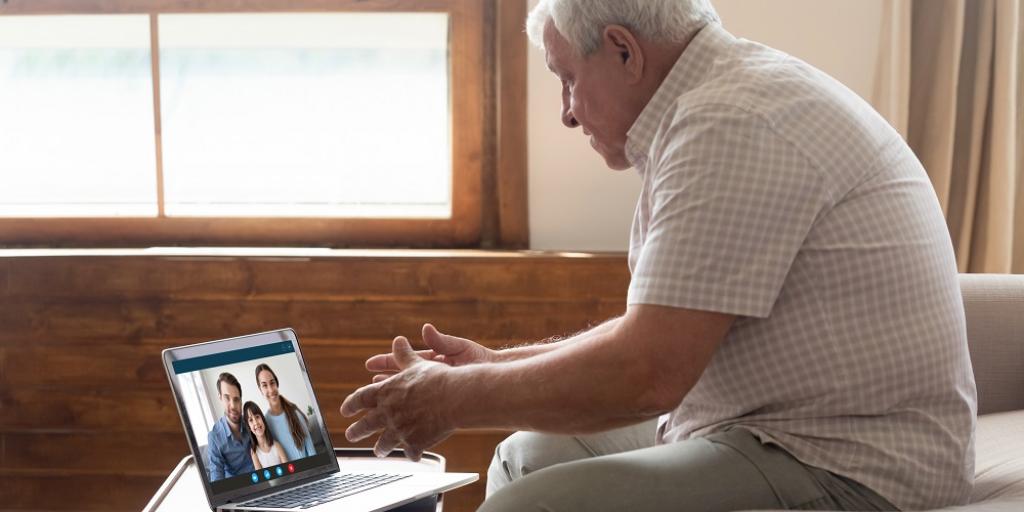VA innovation project saves isolated Vets during pandemic

Everyone has now experienced the “stuck at home” feeling from various shelter-in-place orders over the past year. However, that feeling was particularly difficult for older, disabled, and homeless Veterans who rely on in-person visits from clinicians, loved ones, and social programs.
In early 2020, as COVID-19 rapidly spread around the world, Dr. Thomas Osborne, Chief Medical Informatics Officer for VA Palo Alto and Director of VA’s National Center for Collaborative Healthcare Innovation (NCCHI), was launching “Project Convergence.” This strategic collaboration with Verizon, Microsoft, and Medivis made VA Palo Alto Health Care System (VAPAHCS) the first VA 5G-enabled hospital, and one of the first in the world.
However, as they worked to scale the 5G program, the urgency of the pandemic became palpable. As the U.S. ramped up its efforts to combat COVID-19, Dr. Osborne quickly understood the need to pivot this project to help thousands of Veterans in nursing homes and homeless shelters, who were becoming isolated by the shelter-in-place orders.
“Very early on, I had a feeling COVID was going to be bigger than anyone imagined. Rather than wait and react, we took the risk to change course from our primary work with 5G. We are fortunate to have understanding and skilled collaborators, whose resources allowed us to successfully lead an advanced multipronged battle against COVID-19,” said Dr. Osborne.
Their new mission, coined “Project Convergent Response,” focused on empowering Veterans and caregivers with enhanced wireless technology that could reconnect isolated Veterans with their loved ones.
Converging across the Pacific region
Brian Weaver, the team lead for Verizon, connected Dr. Osborne with Curtis Mentz, who is the senior manager for Verizon’s Critical Response Team on the West Coast. Mr. Mentz, who is also a Veteran, and his team immediately began assessing the network connectivity at Community Living Centers (CLC) at VA campuses in Menlo Park and Livermore, Calif.
Working with the VA Palo Alto’s Office of Facility Planning and Development, they immediately began upgrading equipment. In some places like the Livermore CLC, they found no wireless connectivity at all and installed brand new wireless systems. Every facility saw a dramatic increase in connectivity, allowing Veterans to video-call their loved ones for the first time. VA staff reported dramatic increase in the morale of their patients; some Veterans transformed almost overnight, emerging from depression after they were able to reconnect with family and friends.
Dr. Osborne suspected that other facilities would be facing the same challenges and reached out to Ada Clark, Deputy Director of the Sierra Pacific Network (VISN 21) that oversees VA facilities from Las Vegas to the Pacific islands. Together they connected Verizon to facilities in Sacramento and San Francisco, Calif., where they provided similar solutions.
In addition to delivering the critical wireless infrastructure, the team also found a way to provide wireless devices and service plans at no charge. In the Sacramento area alone, they distributed 20 tablets to quarantined patients so they could communicate with family, clergy, and medical staff.
Homeless Veterans in need
The team also realized that there may be poor to no connectivity in Veteran homeless shelters and homeless facilities. As a result, they began working with VA Homeless Coordinators Danica Bogicevic and Melissa Meierdierks, as well as other social workers and homeless shelters across VISN 21. Through this collaboration, they enhanced network connectivity for nearly 200 wireless devices for homeless Veterans to connect with their VA health care teams and loved ones.
Reconnected care
Another unforeseen consequence of the shelter-in-place orders was the need for VA employees to telework. Many VA employees had never worked from home and did not have reliable internet or wireless signal. To combat this issue, the team identified those in need and shipped more than 20 hot spots to employees throughout VISN 21.
One case even found a clinician whose home had essentially no service at all. Verizon sent a team who was able to lock onto a distant signal with a specialized directional antenna and opened a channel to give her full connectivity.
Today, Dr. Osborne, Mentz, and their teams are still standing by to support the VA’s COVID-19 response. Verizon has also shown a commitment to help support VA around the nation to ensure our Veterans are connected to the best possible care.
“There's no higher honor than to be able to work with the talented medical and technical staff of VA to bring ideas and solutions to help prepare for and combat this deadly virus. Knowing our work will help care for the men and women of our armed forces is humbling, to say the least,” said Mentz.
The National Center for Collaborative Healthcare Innovation (NCCHI) leads partnerships, like Project Convergence and Project Convergent Response, to solve the greatest health care challenges facing Veterans. Located in Silicon Valley, NCCHI collaborates broadly with industry partners, other government agencies, academia, and throughout VA to create far-reaching positive impact for our Veterans with cutting-edge technologies.
